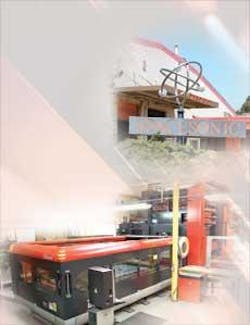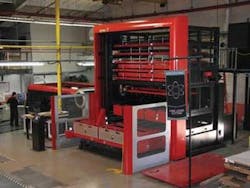Laser cutter improves
Having new technology in house was enough to bring unexpected business
by Jason Hillenbrand
The CEO of Spacesonic Precision Sheet Metal (San Carlos, CA; www.spacesonic.com), Ignacio “Nacho” Palomarez III, is the first to tell you he knew they were heading into the “abyss” of a recession when he purchased his newest laser system. Actually he knew the recession had started, but his company had not seen the worst of it yet. So it raises the questions of “why buy now?” and “how is that working out for you?” Palomarez compares the timing of the purchase to stealing home plate in baseball, where the runner tries to read the pitcher and gauge the best time to make his break. In the end it boils down to gut feeling and experience.
Spacesonic has plenty of experience. The company, started in 1967 by the late Ignacio Palomarez II, is located in the heart of the Silicon Valley, a spawning ground for start-up companies. In this climate Spacesonic learned the value and necessity of flexibility in precision fabrication. As Nacho says, “being located in Silicon Valley, we have seen all walks of manufacturing life come through the door.” Today, Spacesonic is still a family-run company with relatives heavily involved in the day-to-day operations.
In September 2008, Spacesonic went online with its newest machine, an Amada LC3015F1NT, positioning the company to handle whatever work might come its way. Figuring he had at least a year before an upturn in the market, Palomarez thought this would be the best time for his company to bring in the latest technology, learn it, and be prepared to run at maximum capacity once the economy came back. What happened was more than he had bargained for. As Palomarez puts it, “I’m just glad we did it. I’d say 30% of the work we have now would have been a no quote had we not had this laser on the floor.”
The LC3015F1NT purchased by Spacesonic is a 5ft x 10ft, 4kW flying optic laser system with a standard shuttle table configuration. It utilizes many of the latest advances in resonator and motion system technology, which has enabled Spacesonic to venture into new material and thickness areas. The F1 uses linear drives in all 3 axes and has a new 4000-watt RF-excited resonator that provides better beam quality than before. Another new feature is the no-lens-change technology, which allows for a full range of thick to thin material to be processed without the need for an operator to change cutting lenses.
“We’re cutting thicker material, we’re cutting tighter tolerances, we’re cutting much faster than we were cutting before” says Palomarez. “The accuracy from this machine in thin to thick material is just fantastic.”
Additionally the company is now able to process work that it was not able to do on its older lasers in the past. Spacesonic installed its first laser around 1988 and had a total of four lasers prior to installing the F1 machine. Palomarez says the F1 was on his floor for about three to four months before he truly understood the full impact of this machine on his operations. When Spacesonic first installed the F1, it came with the standard shuttle table, which externalized the load and unload process, but still required a person to load and unload the material. The shuttle table allows the machine to be loaded and unloaded while the laser continues to cut but it is a one sheet at a time process that requires the attendance of an operator to handle the material. “The only real issue we had with it was getting people to come in on Saturday and Sunday to load it up. So when the opportunity came to add a loader to it, I took it,” explains Palomarez. “And now you just load it up, set it in, and it runs.”
Palomarez is referring to the ASF (Auto Storage Fork) tower automation system that was retrofitted in early 2009. The ASF takes up minimal floor space, occupying the area previously used by the shuttle table. It stores pallets of raw material and automatically loads and offloads sheets so that the F1 can now be operated without any manual setup or intervention.
According to Palomarez, this is a paradigm shift in how the company uses lasers. “We had four other lasers on the floor before the F1 came in. Now we had to shift our thinking to how much smaller a hole we can cut into the thickness of material; that is the ratio of the thickness to the diameter of the hole. We are producing the smallest (diameter) holes we have ever seen. As a matter of fact, we didn’t know it (the new laser) could do some of the things that it did.”
Palomarez, referring to the cleanliness of the cut and how Spacesonic has reduced secondary operations, says, “We are able to do pretty good with our other machines, but this one consistently leaves us without the dross. We’re skipping two other operations and going right into bending.”
When asked how this has affected the other lasers in his facility, Palomarez confirms that they have pulled work from these to run it through the F1. “Speed, accuracy, quality of cut; it just contributes down the road. You have to remove less dross and scratches, ream fewer holes; you just do less of what you have to do with the other machines.” They make sure to load the F1 with what the other machines cannot do well, while only giving the older lasers jobs that they can do well.
All of this has helped Spacesonic to attract customers. “Customers are not only impressed with the looks of the machine but, more importantly, the performance,” says Palomarez. The F1 machine incorporates a full enclosure that is stylish and functional. This enclosure opens on the front and side of the machine for easy access if needed. And the entire system takes up the minimal amount of floor space. The new laser, located near the front offices of the facility, has become a great tool for introducing the company’s capabilities and willingness to invest in the future to existing and potential new customers.
Over the years, Spacesonic has been at the forefront of fabricating technology. Palomarez refers to a key reason for upgrading: “The newest technology makes that handshake between the machine and the operator on the floor easier. So now the operator, regardless of skill level, is more capable of running the machine because the machine requires less from that operator.” What he is referring to is the ability of the laser system to go from one job to the next without the need for a setup. Right now, the only machine setup required for Spacesonic’s F1 is a nozzle change on certain jobs. The F1 is also available with an automatic nozzle changer that, in combination with the no lens change feature, would eliminate operator setup completely. As Palomarez puts it, “the ease of operation is a big kicker.”
All of this has placed Spacesonic in a position to aggressively deal with the more trying times of today’s market as well as be in a position to handle the capacity requirements of an eventual stronger market. “We knew we were throwing the dice and not everybody else was going to throw them,” explains Palomarez. “So we are in a prime position once this market changes.” As Palomarez explains it, the F1 has made his company more diversified, allowing them to compete for more jobs, shorten their lead times, and giving them a powerful tool to compete globally as well as at home. Palomarez says that diversification is the key to success at this juncture: “You know our counterparts on the other side of the ocean are making the adjustment to become faster at delivery during this recession.”
As for the future of Spacesonic, Palomarez cannot say for sure what is next, but he is very content with the company’s new position, “I feel like a fisherman who just increased the size of his fishnet by three or four fold.” Regardless of how the industry sways, Spacesonic has certainly made that commitment to invest in itself, its customers, and the US manufacturing market. The F1 from Amada has been a key part of that move. Those who know him know that Nacho is optimistic in all aspects of life, so his outlook on the future of manufacturing is no different. But he summed it up best during the interview when asked how he was doing. His response, “Life is great. I am happy to be in business, happy to be alive. What more could I ask for.”
Jason Hillenbrand ([email protected]) is laser product manager for Amada America Inc. (www.amada.com).



